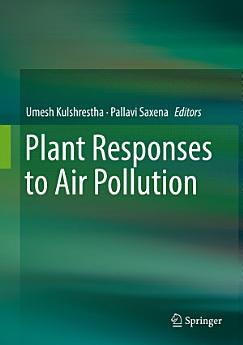Plant Responses to Air Pollution
關於這本電子書
During past few decades, air pollution and poor air quality have been the issues of common concerns. Degraded air has adverse effects on various system of plants by creating a stress which develops biochemical and physiological disorder in plants. Chronic diseases and/or lower yield have reported consequences of air pollution effect. A large number of biochemical and physiological parameters have been used to assess impact of air pollution on plant health. Photosynthetic machinery and respiratory system are the most affected domain of plants. However, the survival of plants depend on various internal and external factors such as plant community, types of air pollutants, geographical region, meteorological conditions and soil moisture etc. Plants respond to both biotic and abiotic stresses accordingly. Many tolerant plants survive easily even in higher air pollution region. Certain plant species absorbs selected gaseous air pollutants and hence plants are effective tool for air pollution remediation.
關於作者
Umesh Kulshrestha is a professor at the School of Environmental Sciences, Jawaharlal Nehru University, New Delhi. He is Deputy Director of South Asia Nitrogen Center. He has 22 years of experience in Environmental Sciences. His area of expertise includes aerosol and precipitation chemistry relevant to climate change, air pollution and plant health, reactive nitrogen, air pollution chemistry and transport, atmospheric depositions and biogeochemical cycle etc. Prof. Kulshrestha is a recipient of the START Young Scientist Award by IGBP-START, USA, Thomas Kuhn Honor Pin by IUAPPA and International Academy of Sciences, CSIR Young Scientist Award, and MS Krishnan Gold Medal by the Indian Geophysical Union (IGU). Also, he is a Fellow of IGU. He has published a number of papers which have been widely cited. He has been associated with various international and national programmes on atmospheric science including Indian Ocean Experiment (INDOEX), Asian Brown Cloud (ABC), IGAC-DEBITS-CAD (Composition of Asian Deposition), Composition of Asian Aerosol and Precipitation (CAAP), Surya, ISRO-GBP-Integrated Campaign on Aerosol Radiation Budget (ICARB), etc.
Pallavi Saxena is a Young Scientist at School of Environmental Sciences, Jawaharlal Nehru University, from 2014 onwards. She has done her postdoc from the Space and Atmospheric Sciences Division, Physical Research Laboratory (PRL), Ahmedabad, Gujarat. She has completed her doctor of philosophy in environmental science from the University of Delhi on the topic “Effect of Photochemical Pollutants on Plant Species” in 2013. Her area of interest is air pollution and plant physiology. She has been working in this area for the last 9 years. She has also been awarded University Grants Commission Junir Research Fellowship (UGC, JRF) (2007–2008), Jawaharlal Nehru Doctoral Scholarship (2009–2010) and Council of Scientific and Industrial Research Senior Research Fellowship (CSIR SRF) (2012–2013) during her doctoral studies. She has been a recipient of postdoctoral fellowships like Indian Space Research Organization (ISRO) fellowship in Physical Research Laboratory (PRL) (2013–2014) and DST Fast Track Young Scientist at School of Environmental Sciences to pursue her independent project (2014–2017). She has published 13 research papers in international and national journals with high impact factor. She has also been an invited speaker on “Variation in the Concentration of VOCs in Atmosphere at Selected Sites in Delhi”, at the “bVOCs Monitoring and Modelling” workshop at Lancaster Environment Centre, Lancaster University, UK (2011). She is also an expert of TOAR International Meeting, which focuses on tropospheric ozone and its impact on vegetation, from 2015 onwards. In addition to that, she has been a recipient of various awards like the Young Scientist Award from the Indian Society of Plant Physiology (2013) and DBT Bio-CARe Award (2014) and several travel grant awards from World Meteorological Organization (WMO), International Global Atmospheric Chemistry (IGAC) and National Oceanic and Atmospheric Administration (NOAA) to participate as an expert in the Ozone Pollution and Its Impact on Vegetation in Trpospheric Ozone Assessment Report (TOAR) Meeting (2015–2016). She has also reviewed research articles for reputed journals, like Atmospheric Environment (Elsevier) and Mitigation and Adaptation of Strategies for Global Change (Springer), Environmental Technology (Taylor and Francis), Polish Journal of Environmental Studies, Environmental Monitoring and Assessment (Springer) and International Journal of Physical Sciences (Academic Journal). She has participated in various national (10) and international conferences (8) and presented several papers. Dr. Saxena has also participated in various workshops and trainings (15) in the area of air pollution and plant physiology.






